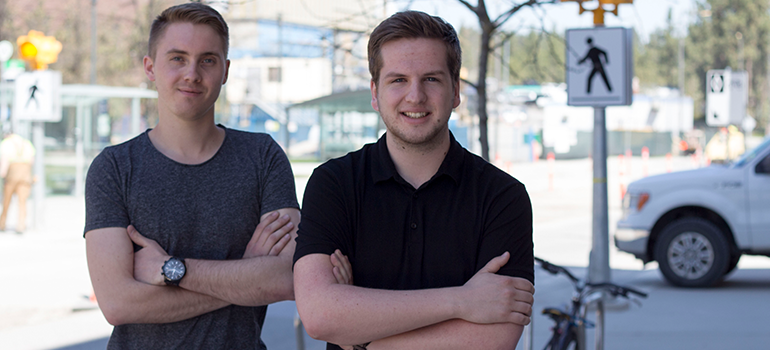A pair of visiting researchers are collaborating with the Sustainable Transport Safety Research Lab at UBC’s Okanagan campus to make the busy 6-lane divided Highway 97 (Harvey Avenue) through Kelowna more vibrant, aesthetic and safer.

The two undergraduate students from Rotterdam University of Applied Science (RUAS), Bas de Wilde and Martijn van Blijswijk, are working under the supervision of the UBCO School of Engineering’s Associate Professor Gord Lovegrove.
‘We’ve asked them to build upon some new Dutch sustainable community design concepts and consider how they would be applied to address Okanagan quality of life concerns reported in the latest Kelowna citizen survey” says Lovegrove.
The product of their efforts will be a Highway 97 corridor system design, one that integrates adjacent land uses, highway and non-highway traffic, pedestrians and cyclists, surrounding public spaces, and a possible future regional electric passenger rail. Using Dutch ‘functional ambiance’ principles, their design will aim to promote a more desirable experience for highway users and non-users, one that can be sustained while meeting economic, environmental, and social strategic and operational priorities of the City and Province – safety, mobility, noise, aesthetics, and air quality, to name a few.
All undergraduate students in the Netherlands are required to complete a 5-month work-related internship, and this project meets that criteria.
Utilizing the Functional Ambiance model that takes into account 8 design components, the students are building a plan that will integrate physical safety features with an increased natural esthetic into a stretch of Kelowna’s busiest highway.
The project requires both urban planning and civil engineering skills, which makes it ideal for these two students as de Wilde is finishing his degree in Urban Planning while Blijswijk is completing his degree in Civil Engineering.
Lovegrove has forged a strong connection with the Netherlands since he began offering a summer Go Global program entitled “Sustainable Community Systems Engineering: The Netherlands”. His collaboration with the RUAS ultimately led to these students taking on this project.
According to Lovegrove, we can learn a lot from the way the Netherlands approaches planning and policy. “The Netherlands uses so many innovative approaches to plan and design communities that effectively achieve a desirable quality of life that can be sustained (i.e. sustainable communities)! With a bit of tweaking these approaches could work for us in Canada as well.”
The students have been at UBC since January, and have already completed most of the background research via literature reviews, data collection and analysis.
“The complexity and diversity of redesigning highway 97 is immense” explains de Wilde. “We have narrowed our study to improve safety and the esthetic within a section of the highway near downtown.”
Safety is an important factor explains Lovegrove, but ultimately we want to help Kelowna become a more sustainable community especially along this busy transportation corridor.
According to Blijswijk, the research is not as easy as simply taking some Dutch ideas and making them work within the Okanagan context. “Making this stretch of highway safer isn’t the hardest facet of this program, what is the hardest facet is juggling that safety component with a focus on making the area more sustainable and vibrant.”
While most of the intense research is behind them, both Blijswijk and de Wilde are looking forward to developing a plan that may change the future outlook for highway 97 as it moves through Kelowna.
In the meantime, the two students will continue to explore Kelowna and its surroundings.
“So far this has been an amazing experience, and we have been spreading the word amongst our classmates back home that UBC Okanagan School of Engineering is a great place to visit” says de Wilde.